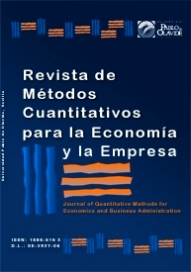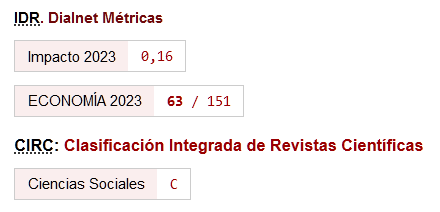Riesgo y persistencia de las ganancias
DOI:
https://doi.org/10.46661/rev.metodoscuant.econ.empresa.9594Palabras clave:
persistencia de ganancias, calidad de ganancias, riesgo, betaResumen
¿Qué puede hacer la gerencia financiera de las pequeñas industrias y otras empresas, particularmente en los países en desarrollo, para disminuir la percepción de riesgo de estas ante los inversionistas? Disminuir el beta le permitiría a estas empresas acceder a capital a un menor costo, lo cual podría llegar a tener un impacto favorable en la valuación de las mismas. ¿Podría hacer algo la gerencia financiera para reducir el riesgo no diversificable?
El objetivo de este trabajo es aportar nuevos elementos, al debate ya existente, en cuanto a si factores propios o inherentes de la empresa pueden incidir o no sobre el riesgo no diversificable de la empresa, medido por medio del beta. Para tal fin, se elaboró un panel de datos balanceado y corto, el cual cuenta con 603 empresas que cotizan en bolsas de valores latinoamericanas y durante un período de tiempo relativamente pequeño (2016-2021).
Para las empresas mexicanas se encontró que a mayor Persistencia de las ganancias mayor beta. Si bien la adopción de estándares contables internacionales puede mejorar la Calidad de las ganancias de las empresas, esta adopción también puede afectar su capitalización bursátil. Mientras que, por sector económico, independiente del país de origen, se encuentra que en el sector bancario y en el de producción agrícola, a mayor Persistencia de las ganancias menor riesgo.
Descargas
Citas
Ali, A., & Zarowin, P. (1992). The role of earnings levels in annual earnings-returns studies. Journal of Accounting Research, 30(2), 286-296. https://doi.org/10.2307/2491128.
Amir, E., Einhorn, E., & Kama, I. (2013). Extracting sustainable earnings from profit margins. European Accounting Review, 22(4), 685-718. https://doi.org/10.1080/09638180.2012.749067.
Artikis, P. G., & Papanastasopoulos, G. A. (2016). Implications of the cash component of earnings for earnings persistence and stock returns. The British accounting review, 48(2), 117-133. https://doi.org/10.1016/j.bar.2016.02.002.
Birch, D. L., Mass.). Program on Neighboorhood Massachusetts Institute of Technology (Cambridge, Change, R., & Mass.). Program on Neighboorhood and Regional Change Massachusetts Institute of Technology (Cambridge. (1979). The job generation process (Vol. 302, p. 1979). Cambridge, MA: MIT program on neighborhood and regional change.
Burke, Q. L., & Warfield, T. D. (2021). Bank interest rate risk management and valuation of earnings. Accounting & Finance, 61(3), 4287-4337. https://doi.org/10.1111/acfi.12733.
Collins, D. W., & Kothari, S. P. (1989). An analysis of intertemporal and cross-sectional determinants of earnings response coefficients. Journal of Accounting and Economics, 11(2-3), 143-181. https://doi.org/10.1016/0165-4101(89)90004-9.
Chinzara, Z. (2010). Macroeconomic uncertainty and emerging market stock market volatility: The case for South Africa. Economic Research Southern Africa, 187, 1-19.
https://doi.org/10.1111/j.1813-6982.2011.01262.x
Darnell, M., Peters, E., & Ye, J. (2009). Rethinking Beta. FQ Perspective, 6(01), 1-5.
Dechow, P., Ge, W., & Schrand, C. (2010). Understanding earnings quality: A review of the proxies, their determinants and their consequences. Journal of Accounting and Economics, 50(2-3), 344-401. https://doi.org/10.1016/j.jacceco.2010.09.001.
De Long, J. B., Shleifer, A., Summers, L. H., & Waldmann, R. J. (1990). Noise trader risk in financial markets. Journal of Political Economy, 98(4), 703-738. https://doi.org/10.1086/261703.
Delis, M. D., Hasan, I., Iosifidi, M., & Li, L. (2018). Accounting quality in banking: The role of regulatory interventions. Journal of Banking & Finance, 97, 297-317. https://doi.org/10.1016/j.jbankfin.2018.10.005.
Dragan, M., Mijić, K., & Jakšić, D. (2018). Opportunistic management behavior in reporting earnings of agricultural companies. Custos e Agronegocio on line, 14(1), 125-142.
Easton, P. D., & Zmijewski, M. E. (1989). Cross-sectional variation in the stock market response to accounting earnings announcements. Journal of Accounting and Economics, 11(2-3), 117-141. https://doi.org/10.1016/0165-4101(89)90003-7.
Estrada, J. (2002). Systematic risk in emerging markets: the D-CAPM. Emerging Markets Review, 3(4), 365-379. https://doi.org/10.1016/S1566-0141(02)00042-0.
Fairfield, P. M., & Yohn, T. L. (2001). Using asset turnover and profit margin to forecast changes in profitability. Review of Accounting Studies, 6, 371-385. https://doi.org/10.1023/A:1012430513430.
Fernandes, N., & Ferreira, M. A. (2008). Does international cross-listing improve the information environment. Journal of Financial Economics, 88(2), 216-244. https://doi.org/10.1016/j.jfineco.2007.06.002.
Fifield, S. G., McMillan, D. G., & McMillan, F. J. (2020). Is there a risk and return relation?. The European Journal of Finance, 26(11), 1075-1101. https://doi.org/10.1080/1351847X.2020.1724551.
Fonou-Dombeu, N. C., Mbonigaba, J., Olarewaju, O. M., & Nomlala, B. C. (2022). Earnings quality measures and stock return volatility in South Africa. Future Business Journal, 8(1), 1-15. https://doi.org/10.1186/s43093-022-00115-x.
García, M. D. P. R., Alejandro, K. A. C., Sáenz, A. B. M., & Sánchez, H. H. G. (2017). Does an IFRS adoption increase value relevance and earnings timeliness in Latin America? Emerging Markets Review, 30, 155-168. https://doi.org/10.1016/j.ememar.2016.11.001.
Gaio, C. (2010). The relative importance of firm and country characteristics for earnings quality around the world. European Accounting Review, 19(4), 693-738. https://doi.org/10.1080/09638180903384643.
Graham, J. R., Harvey, C. R., & Rajgopal, S. (2005). The economic implications of corporate financial reporting. Journal of Accounting and Economics, 40(1-3), 3-73. https://doi.org/10.1016/j.jacceco.2005.01.002.
Gregory, A., Whittaker, J., & Yan, X. (2016). Corporate social performance, competitive advantage, earnings persistence and firm value. Journal of Business Finance & Accounting, 43(1-2), 3-30. https://doi.org/10.1111/jbfa.12182.
Hesarzadeh, R., & Bazrafshan, A. (2018). Corporate reporting readability and regulatory review risk. Baltic Journal of Management, 13(4), 488-507. https://doi.org/10.1108/BJM-11-2017-0357.
Karahan, F., & Ozkan, S. (2013). On the persistence of income shocks over the life cycle: Evidence, theory, and implications. Review of Economic Dynamics, 16(3), 452-476. https://doi.org/10.1016/j.red.2012.08.001.
Kormendi, R., & Lipe, R. (1987). Earnings innovations, earnings persistence, and stock returns. Journal of Business, 323-345.
https://doi.org/10.1086/296400
Kohlbeck, M., & Warfield, T. D. (2007). Unrecorded intangible assets: Abnormal earnings and valuation. Accounting Horizons, 21(1), 23-41. https://doi.org/10.2308/acch.2007.21.1.23.
Lawson, B. P., & Wang, D. (2016). The earnings quality information content of dividend policies and audit pricing. Contemporary Accounting Research, 33(4), 1685-1719. https://doi.org/10.1111/1911-3846.12179.
Lei, Q., Chen, H., & Liang, Z. (2019). Large shareholders' shareholding and earnings' longitudinal persistence. Applied Economics Letters, 26(15), 1294-1300. https://doi.org/10.1080/13504851.2018.1558328.
Lev, B. (1983). Some economic determinants of time-series properties of earnings. Journal of Accounting and Economics, 5, 31-48. https://doi.org/10.1016/0165-4101(83)90004-6.
Liao, F. N., & Chen, F. W. (2021). Independent director interlocks: effects and boundary on the earnings persistence of the firm. Economic Research-Ekonomska Istraživanja, 34(1), 383-409. https://doi.org/10.1080/1331677X.2020.1788965.
Markowitz, H. M. (1959). Portfolio Selection: Efficient Diversification of Investments. Cowles Foundation Monograph, 16.
Markowitz, H. M. (1984). The "two beta" trap. The Journal of Portfolio Management, 11(1), 12-20.
https://doi.org/10.3905/jpm.1984.408976
Nissim, D., & Penman, S. H. (2001). Ratio analysis and equity valuation: From research to practice. Review of Accounting Studies, 6, 109-154. https://doi.org/10.1023/A:1011338221623.
Pimentel, R. C., & Aguiar, A. B. D. (2016). The role of earnings persistence in valuation accuracy and the time horizon. Revista de Administração de Empresas, 56, 71-86. https://doi.org/10.1590/S0034-759020160107.
Santos, M. A. C. D., Mol, A. L. R., Anjos, L. C. M. D., & Santiago, J. S. (2013). Prices lead earnings no Brasil?. Revista Contabilidade & Finanças, 24, 243-256. https://doi.org/10.1590/S1519-70772013000300007.
Sharpe, W. F. (1964). Capital asset prices: A theory of market equilibrium under conditions of risk. The Journal of Finance, 19(3), 425-442. https://doi.org/10.1111/j.1540-6261.1964.tb02865.x.
Sharpe, W. F. (1975). Adjusting for risk in portfolio performance measurement. The Journal of Portfolio Management, 1(2), 29-34.
https://doi.org/10.3905/jpm.1975.408513
Sharpe, W. F. (1984). Factor models, CAPMs, and the ABT. The Journal of Portfolio Management, 11(1), 21-25.
https://doi.org/10.3905/jpm.1984.408982
Sharpe, W. F., & Litterman, R. (2014). Past, present, and future financial thinking. Financial Analysts Journal, 70(6), 16-22. https://doi.org/10.2469/faj.v70.n6.1.
Soliman, M. T. (2008). The use of DuPont analysis by market participants. The Accounting Review, 83(3), 823-853. https://doi.org/10.2308/accr.2008.83.3.823.
Vichitsarawong, T., & Pornupatham, S. (2015). Do audit opinions reflect earnings persistence?. Managerial Auditing Journal, 30(3), 244-276. https://doi.org/10.1108/MAJ-12-2013-0973.
Wang, J., Steven, X., & Yu, W. (2017). Information environment, systematic volatility and stock return synchronicity (Doctoral dissertation, School of Accounting and Finance, The Hong Kong Polytechnic University), 1-173. http://hdl.handle.net/10397/84535.
Wang, Y., Zhai, Y., Sun, X., & Colombage, S. R. (2020). To what extent do earnings affect the R&D decision of Chinese manufacturing firms? Technology Analysis & Strategic Management, 32(3), 349-362. https://doi.org/10.1080/09537325.2019.1661373.
Wei, L., Li, G., Zhu, X., & Li, J. (2019). Discovering bank risk factors from financial statements based on a new semi‐supervised text mining algorithm. Accounting & Finance, 59(3), 1519-1552. https://doi.org/10.1111/acfi.12453.
Wu, Y. (2018). What's behind smooth dividends? Evidence from structural estimation. The Review of Financial Studies, 31(10), 3979-4016. https://doi.org/10.1093/rfs/hhx119.
Yildiz, M. E., Erzurumlu, Y. O., & Kurtulus, B. (2020). Comparative analyses of mean-variance and mean-semivariance approaches on global and local single factor market model for developed and emerging markets. International Journal of Emerging Markets, 17(1), 325-350. https://doi.org/10.1108/IJOEM-01-2020-0110.
Zhou, X., Lou, P., Wu, Y., & Zhang, L. (2022). Earnings Persistence and Abnormal Audit Fees. Discrete Dynamics in Nature and Society, 2022, 1-12. https://doi.org/10.1155/2022/2659939.
Descargas
Publicado
Cómo citar
Número
Sección
Licencia
Derechos de autor 2024 Juan Fernando Garrido Navia, Jesús-Ancizar Gómez

Esta obra está bajo una licencia internacional Creative Commons Atribución-CompartirIgual 4.0.
El envío de un manuscrito a la Revista supone que el trabajo no ha sido publicado anteriormente (excepto en la forma de un abstract o como parte de una tesis), que no está bajo consideración para su publicación en ninguna otra revista o editorial y que, en caso de aceptación, los autores están conforme con la transferencia automática del copyright a la Revista para su publicación y difusión. Los autores retendrán los derechos de autor para usar y compartir su artículo con un uso personal, institucional o con fines docentes; igualmente retiene los derechos de patente, de marca registrada (en caso de que sean aplicables) o derechos morales de autor (incluyendo los datos de investigación).
Los artículos publicados en la Revista están sujetos a la licencia Creative Commons CC-BY-SA de tipo Reconocimiento-CompartirIgual. Se permite el uso comercial de la obra, reconociendo su autoría, y de las posibles obras derivadas, la distribución de las cuales se debe hacer con una licencia igual a la que regula la obra original.
Hasta el volumen 21 se ha estado empleando la versión de licencia CC-BY-SA 3.0 ES y se ha comenzado a usar la versión CC-BY-SA 4.0 desde el volumen 22.










